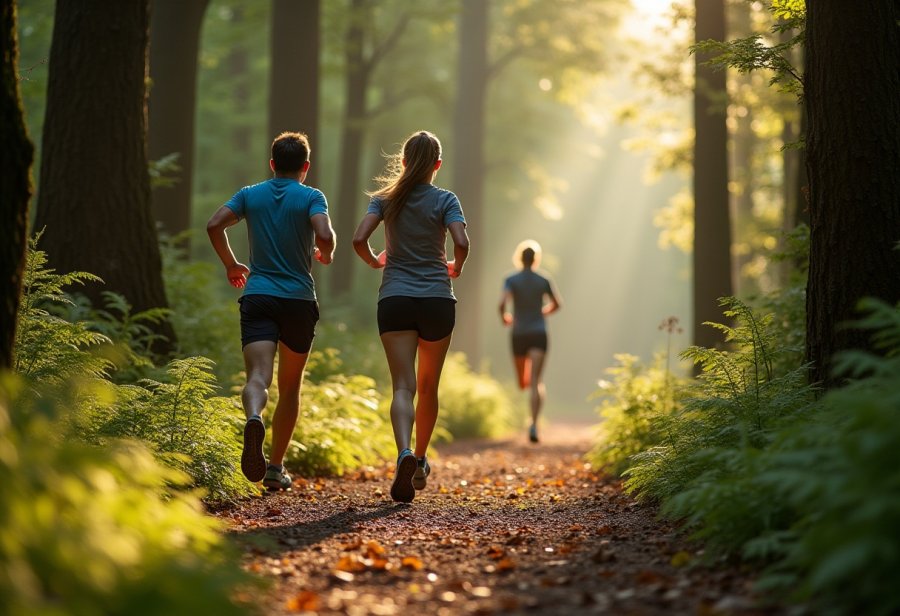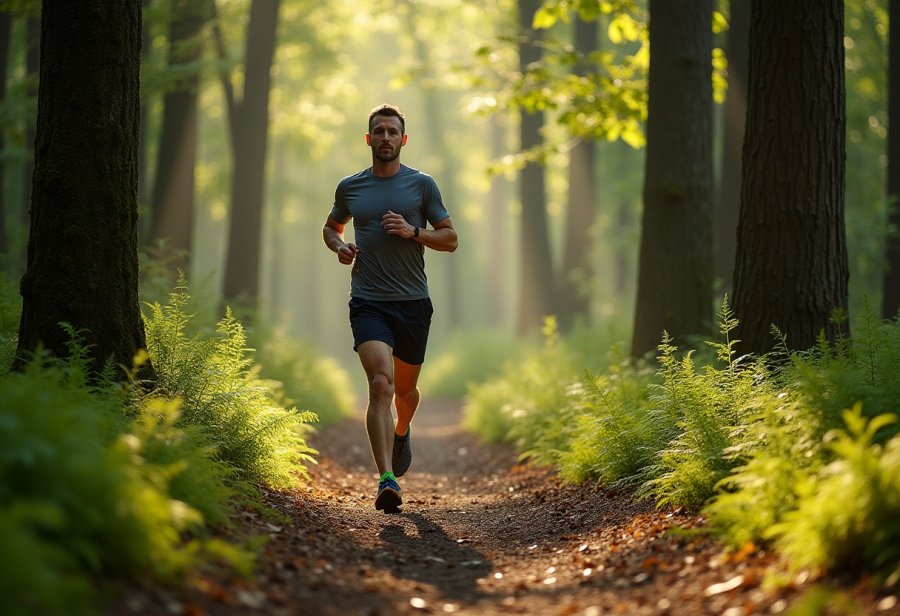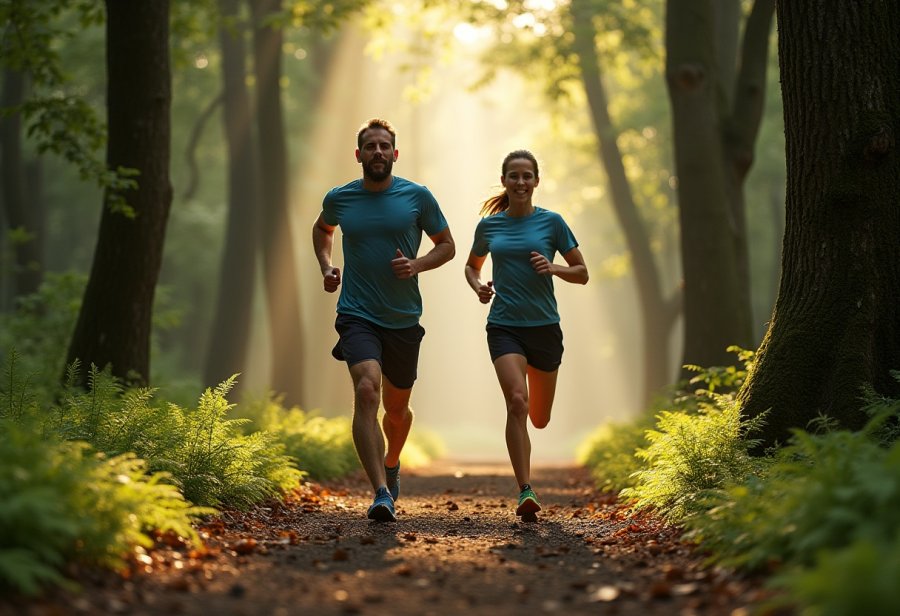
Imagine a workout that invigorates your body while soothing your mind—could trail running be the secret to lasting wellness amidst life’s chaos? This exploration reveals how immersing in nature’s beauty transforms exercise into a holistic experience, blending physical endurance with mental clarity. From ancient wisdom to modern science, the benefits of outdoor activity—reducing stress, boosting mood, and strengthening muscles—are undeniable. Today’s growing popularity of trail running, supported by innovative technology and eco-conscious practices, demonstrates a collective shift toward sustainable self-care. Yet, challenges remain: accessibility, safety, and environmental impact. Could embracing nature-based routines foster resilience, community, and environmental stewardship? As science, tradition, and technology converge, outdoor fitness emerges not just as a trend but as a vital pathway to balance, vitality, and lasting wellness. Will you take the trail toward a healthier, more mindful life?

Embrace Nature’s Run: Unlocking Physical and Mental Wellness
Running through nature offers a refreshing change from the usual gym or pavement jogs. There’s something inherently invigorating about stepping onto a trail—winding through forests, climbing mountain paths, or exploring local green spaces—that transforms exercise into a true adventure. It’s not just about burning calories; it’s about immersing yourself in an environment that calms the mind while challenging the body. The natural scenery, fresh air, and varied terrain combine to create a workout experience that nurtures both physical health and mental well-being.
This connection between outdoor activity and wellness isn’t a new discovery. For centuries, cultures around the world have recognized the benefits of being active in natural settings. Ancient Greek athletes trained outdoors, knowing that connecting with nature could boost endurance and strength. Today, science confirms what they knew—spending time in green spaces can lower stress hormones and improve mood. Trail running, in particular, amplifies these benefits by engaging muscles in ways flat surfaces can’t, thanks to uneven terrain and natural obstacles.
As you navigate a trail, your body adapts to changing surfaces, which helps improve coordination and strengthens stabilizing muscles. These small adjustments can reduce injury risk and enhance endurance over time. The softer ground of natural trails also puts less impact on joints compared to concrete or asphalt, making it a smarter choice for those seeking a lower-impact workout that still delivers results. Over time, these physical benefits support a healthier, more resilient body.
Equally important are the mental benefits that come from running in nature. Being outdoors reduces stress hormones like cortisol, helping you feel calmer and more centered. The rhythmic cadence of trail running acts like a form of moving meditation, clearing mental clutter and fostering mindfulness. The sights, sounds, and scents of nature—birds chirping, leaves rustling, earth’s aroma—serve as a calming backdrop, making it easier to disconnect from digital distractions and urban noise.
Humans have long had a close relationship with nature, and modern research now confirms what many ancient traditions instinctively understood—that outdoor activity can heal and energize us. Spending time in green spaces activates relaxation responses in the nervous system, aiding recovery from stress and mental fatigue. Trail running, combining physical challenge with immersion in natural beauty, offers a holistic approach to health that nourishes both body and mind. Each run becomes more than exercise—it’s a step toward balance, clarity, and a deeper appreciation for the natural world.
From Ancient Wisdom to Modern Science: The Roots of Outdoor Health Benefits
The idea that outdoor exercise benefits our health isn’t new; it’s rooted in centuries of human experience. Ancient civilizations such as the Greeks and Egyptians understood that being active in natural settings could boost vitality and strength. Greek athletes, for example, trained outdoors, recognizing that connecting with nature enhanced endurance and overall well-being. These early practices laid a foundation that modern science now builds upon, confirming that physical activity in green spaces supports health on multiple levels.
In recent decades, research has provided clear evidence backing these age-old insights. Studies show that spending time in natural environments can lower cortisol levels, the hormone linked to stress, and improve mood. When we immerse ourselves in green spaces, our nervous system responds differently than it does in urban settings or on a treadmill, often promoting a sense of calm and mental clarity. The sensory experiences—birds singing, leaves rustling, earth’s earthy scent—engage our parasympathetic nervous system, helping us relax and recover from mental fatigue.
The concept of “nature therapy,” or ecotherapy, has gained prominence within the health community. It emphasizes that our emotional and mental well-being are deeply intertwined with our environment. Engaging with nature through activities like trail running or forest bathing activates relaxation responses that combat anxiety and promote mindfulness. These natural stimuli—sound, sight, smell—encourage us to stay present, reducing the mental clutter caused by digital overload and urban chaos.
Cultural attitudes towards outdoor activity have evolved significantly. Once associated mainly with military drills or spiritual rituals, outdoor exercise is now widely recognized as essential for mental health and holistic wellness. Movements like Forest Bathing highlight the calming effects of slow, sensory-rich engagement with nature, reinforcing the idea that mental health benefits are as vital as physical gains. Influential figures and ongoing research continue to highlight how green spaces support emotional resilience and overall well-being.
Today’s understanding of outdoor fitness integrates both historical wisdom and scientific validation. It’s no longer seen solely as a way to stay physically fit but as a crucial component of mental health. When we spend time in natural settings, our bodies activate relaxation responses that counteract stress and restore mental balance. This holistic perspective encourages us to reconnect with nature not just as a physical activity but as a vital part of a healthy, balanced life.
As awareness grows, the link between outdoor exercise and mental resilience becomes more prominent. Green spaces act as natural antidotes to the stresses of modern life, fostering emotional stability and clarity. Scientific studies continue to reinforce that outdoor activity supports both physical and mental health, making it a powerful tool for long-term wellness. This shift toward valuing nature’s healing potential is shaping a new approach to health—one that emphasizes harmony with the environment as essential for thriving in today’s fast-paced world.

Trail Running Today: A Movement of Wellness and Connection
Today, outdoor fitness, especially trail running, is more popular than ever. More people are seeking active ways to boost their mental and physical health, moving beyond the traditional gym or treadmill routine. Trail running offers a compelling combination of exertion and mental refreshment that’s hard to find indoors. Thanks to advances in technology—like GPS devices and trail-specific apps—discovering new routes and tracking progress has become easier, inspiring both beginners and seasoned runners to explore natural landscapes more frequently.
Social media plays a big role in fueling this trend. Scenic photos, inspiring stories, and shared adventures help normalize outdoor fitness as an integral part of a balanced lifestyle. This visibility encourages a diverse range of people—whether just starting out or already experienced—to see trail running as accessible and rewarding. Many now view it as a way to combine movement with mindfulness, providing a mental escape from daily stresses while deepening their connection to the environment.
Despite the growth, challenges remain. Uneven terrain, wildlife encounters, and unpredictable weather can pose risks, especially for those new to trail running. Accessibility is another issue—not everyone lives near suitable natural areas or has the means to travel to trails regularly. Without proper guidance or structured programs, incorporating outdoor exercise sustainably can be difficult. Addressing these obstacles is key to making outdoor fitness more inclusive and approachable for everyone.
Innovations are continually shaping how we engage with outdoor wellness. Practices like mindfulness running, which emphasizes paying close attention to breath and surroundings, turn exercise into a meditative experience. Forest bathing, or shinrin-yoku, encourages leisurely walks designed to absorb the calming effects of nature. Technology also plays a role here, with virtual guided trail experiences and eco-friendly apps promoting responsible outdoor recreation, helping deepen mental health benefits while respecting the environment.
Environmental consciousness influences the outdoor fitness community more than ever. Participants now prioritize eco-friendly practices—sticking to designated trails, minimizing impact, and supporting conservation efforts. This shift ensures that natural spaces remain preserved and accessible, fostering a respectful relationship with the environment. Such attitudes help sustain the very landscapes that make outdoor activities meaningful, creating a cycle of health and stewardship.
Cultural attitudes toward outdoor activity have shifted significantly. Once linked mainly to military training or competitive sports, outdoor pursuits are now widely embraced as vital for mental and physical wellness. Movements like eco-therapy and Forest Bathing highlight the importance of mindful engagement with nature. Social media and global wellness communities continue to promote activities like trail running, emphasizing their role in building resilience, fostering community, and cultivating a deeper appreciation for the natural world.
For those interested in taking their trail running experience further, exploring curated resources can be highly beneficial. Learning about local organizations or programs dedicated to outdoor fitness can provide guidance and foster a sense of community. To discover more about how to get started or find support, check out this helpful guide on trail running resources.
Cultivating Wellness: Practical Strategies for Outdoor Running Success
Incorporating outdoor running into your wellness routine starts with simple steps. Begin by scouting nearby parks, trails, or green spaces that feel accessible and inviting. Even a brief 10-15 minute jog in a familiar spot can establish a foundation of consistency. As comfort grows, gradually increase your time or explore new routes to keep your routine fresh and engaging. The key is to prioritize regularity over intensity, turning outdoor running into a sustainable habit rather than a workout chore.
Choosing the right gear makes a noticeable difference. Invest in trail shoes that offer good grip and support to handle uneven terrain safely. Dress in moisture-wicking layers suited for the weather, and carry essentials like water, sunscreen, and a hat to stay protected. When you’re properly equipped, stepping outside becomes less of a challenge and more of an opportunity. Comfort and safety naturally encourage you to stick with it, transforming outdoor running from a task into a pleasure.
Mindfulness adds depth to your outdoor runs. Instead of rushing through, focus on your breath, the sounds of nature—birds singing, leaves rustling—or the sensation of your feet on the trail. This awareness turns your run into a moving meditation, helping clear mental clutter and reduce stress. Over time, these moments of presence can boost mental clarity and emotional balance, making your outdoor activity a vital part of your mental health toolkit.
Tracking your progress can boost motivation and provide clarity. Use a journal or a dedicated app to log distances, routes, and how you feel afterward. Pay attention not only to physical improvements but also to emotional shifts—feeling more relaxed, focused, or energized. Recognizing these benefits reinforces your commitment and helps you see outdoor running as more than just exercise—it’s a pathway to overall well-being.
Adding variety keeps your routine interesting and enhances its benefits. Incorporate mindful practices like paying close attention to your surroundings or slow, sensory-rich walks called forest bathing. Mixing in outdoor yoga or bodyweight exercises can create a full-body approach that boosts strength and mental relaxation. These variations prevent routine fatigue and deepen your connection with nature, making each session more enriching.
Safety and respect for the environment should always guide your outdoor activities. Stick to designated trails, avoid disturbing wildlife, and carry essentials like a water bottle, basic first aid kit, and a charged phone. Practice eco-friendly habits—leave no trace, pick up litter, and stay on established paths—to preserve the spaces that support your wellness journey. Approaching outdoor running with mindfulness and care ensures it remains a sustainable, rewarding part of your life.
Finally, embrace the mindset that outdoor fitness is about more than physical gains. It’s a conscious act of self-care that nurtures resilience, mental clarity, and a sense of balance. Each step outside becomes an act of connection—to nature, to yourself, and to a healthier lifestyle. Consistently engaging with the outdoors not only enhances your physical health but also fosters a deeper appreciation for the natural world, creating a ripple effect of wellness that extends beyond the trail.

Looking Ahead: The Future of Outdoor Fitness and Personal Resilience
The outlook for outdoor fitness, especially trail running, is brighter than ever. As more people discover the profound mental and physical benefits of immersing themselves in nature, technology continues to make outdoor activities more accessible and engaging. Smarter apps, wearable devices, and virtual trail experiences help motivate newcomers and seasoned enthusiasts alike, making it easier to explore new routes, track progress, and stay committed to regular outdoor routines. These innovations foster a sense of community and purpose, encouraging more sustained engagement with nature-based wellness.
At the same time, a growing awareness of environmental responsibility is shaping outdoor fitness culture. Participants are increasingly mindful of minimizing their ecological footprint—sticking to designated trails, supporting conservation efforts, and practicing Leave No Trace principles. This shift not only helps preserve the natural spaces that make outdoor activities so valuable but also nurtures a respectful relationship between people and the environment. Such attitudes ensure that these green spaces remain accessible and vibrant for generations to come.
Personal wellness journeys are expanding beyond traditional notions of fitness. Today, outdoor activities are recognized as powerful tools for building resilience, reducing stress, and fostering emotional balance. The focus has shifted from solely performance or aesthetic goals to nurturing mental clarity and fostering sustainable habits. This broader perspective welcomes diverse backgrounds and fitness levels, emphasizing that connecting with nature can be a deeply personal and inclusive experience.
Innovation will likely continue to reshape how we engage with outdoor wellness. Virtual and augmented reality technologies could bring immersive trail experiences into urban environments, making the benefits of nature accessible even in densely populated areas. Community-led events like eco-tours, outdoor festivals, and guided mindfulness walks are poised to grow, transforming outdoor activity into social and educational opportunities. These developments help lower barriers, making outdoor wellness appealing and inclusive for all.
As mental health awareness deepens, outdoor activities such as trail running are increasingly valued as essential self-care practices. Schools, workplaces, and community organizations are beginning to integrate outdoor wellness programs, recognizing their role in reducing stress, boosting focus, and enhancing emotional resilience. This shift promotes a culture where outdoor activity is seen not just as exercise but as a vital component of a balanced, healthy life—one that supports long-term well-being and community vitality.
Sustaining this momentum requires a conscious effort to prioritize safety, accessibility, and ecological stewardship. Small, consistent steps—like local walks or beginner trail runs—can open the door for more people to experience these benefits without feeling overwhelmed. Cultivating curiosity and fostering a respectful attitude toward nature ensures outdoor wellness remains a lifelong, evolving journey. When approached thoughtfully, outdoor fitness becomes more than a routine; it becomes a shared commitment to personal health and environmental preservation.
Looking ahead, the integration of outdoor activity into our daily lives promises a future where health and sustainability go hand in hand. As individuals embrace outdoor wellness as a core part of their lifestyle, communities will grow more resilient and connected. Nature’s healing power, combined with technological innovation and a collective sense of responsibility, sets the stage for a healthier, more mindful world—one step at a time.


